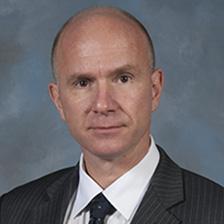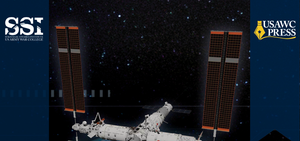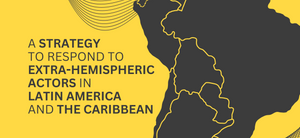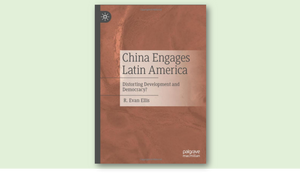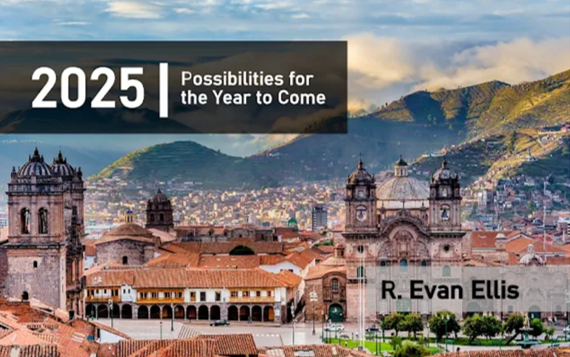
2025: Possibilities for the Year to Come
Introduction
2025 is likely to be a transformative year for Latin America and the Caribbean, and its relationships with the United States, the People’s Republic of China (PRC), and other actors. Although it is impossible to predict with certainty the complex interaction among interdependent events and factors, it is important to recognize the substantial number of elections and key change events that will impact the region this year, the unprecedented quantity of interacting forces that will shape its dynamics, and the possibilities for shocks coming from both within and beyond the region.
A Political Calendar Filled with Change Opportunities
In 2025, Latin America will have a larger number of national elections and other significant political events on its calendar than it did in the very significant electoral year 2024.
The 2025 political calendar will begin with the January 10 “inauguration” of a government in Venezuela, an event that is likely to involve the simultaneous swearing in of the actually elected, “de jure” government of Edmundo Gonzalez, and the “de facto” government of Nicholas Maduro. These events will almost certainly be followed by massive national protests by Gonzalez loyalists, large-scale repression and arrests by Maduro-loyal security forces, and new waves of sanctions by the outgoing U.S. administration and then more by the incoming administration.
Events in Venezuela, in combination with likely initiatives oriented toward the U.S. border and Mexico, will be the “opening acts” of the new administration’s policies toward Latin America and the Caribbean. However, while the year for Latin American politics begins in Venezuela and Mexico, those events will be closely followed by an unprecedented ten elections in which the region’s population will chose new heads of state and national legislative bodies: Ecuador (first round in February, second round in April), Suriname (May), Bolivia (August), Chile (November), Honduras (November), and St. Vincents and the Grenadines (November). There will also be elections on not-yet defined dates, but prior to the end of the year, in Trinidad and Tobago, Jamaica, Guyana, and Belize. The possibility for political change in the Caribbean will be more important than ever in shaping the region’s deepening relationships with China, as well as its responses to the initiatives of the new administration, immigration, gun violence of epidemic proportions, and migratory pressures from Venezuela, Cuba and Haiti, as discussed later.
In addition to elections selecting new Presidents and/or Prime Ministers in the region, in October, Argentina will hold a critically important mid-term election for its National Congress and a range of state and local positions, which will likely have a major impact on the power and confidence of the pro-U.S., Trump-aligned administration of Javier Milei.
Seven Transformative Forces Shaping Regional Dynamics
In the context of the possibilities for change embodied by these and other national political events, seven transformative forces will continue to shape the dynamics of the region in 2025, with most likely to have a stronger impact in 2025 than they had in 2024 (in no particular order): (1) transnational organized crime, (2) migration (3) climate effects, (4) the digital technology revolution, (5) new patterns of US engagement with the region, (6) expanded engagement by the PRC, and (7) a reconfiguration of the Latin American left.
Transnational Organized Crime. In Latin America, faith in democracy is profoundly challenged by frustration with poor government performance in combatting endemic corruption, insecurity and economic malaise, with the region’s anemic 2.2% growth in 2024 projected to continue at a similar rate in 2025. In this context of democratic fragility, the corrosive impact of organized crime through corruption, institutional weakness and violence in much of the region will continue to expand in the coming year.
Flows of highly addictive and lethal fentanyl from precursors in China through labs in Mexico are expanding beyond markets in the United States to gain a foothold in markets in Mexico, Brazil, Argentina and other parts of the region.
The production of cocaine is exploding in the Andean region and diversifying beyond its borders. Indeed, the United Nations Office on Drugs and Crime reported that during 2023, potential cocaine production in Colombia alone grew by 53%. Production has also increased in quantity and the diversity of regions in traditional coca producers Peru and Bolivia. It has also further expanded into Venezuela, parts of Central America, and by some reports, Ecuador. An expanding array of transnational criminal organizations from Colombian groups to Mexico’s Sinaloa and Jalisco Nuevo Generacion Cartels, to the Brazilian First Capital Command (PCC) and Red Command (CV), to Italy’s ‘Ndrangheta and Albanian mafias and Chinese triads are operating and competing in the region.
The continued fracturing of cartels and the proliferation of their armed wings, affiliated gangs, and corrupted citizen militias once established to combat them has increased the violence. The further involvement of these groups in extortion, kidnapping, robbery, and other common criminality to sustain themselves has expanded the ways in which criminality once focused on illicit transnational flows is increasingly felt through crime and violence against Latin Americans.
Illegal mining, which creates grave environmental damage and facilitates laundering of proceeds from other criminality, bringing its own array of criminal enterprises including prostitution and human trafficking, is further compounding the region’s security crisis. These activities have arguably become a growth industry in much of the region in both mountainous and jungle regions from Peru, Ecuador, and Colombia to the Orinoco basin of Venezuela and the interior of Guyana and Suriname.
The Expanding Migration Crisis. Compounding the effects of expanding criminality, the migration crisis affecting the region is only likely to worsen in the coming year. The likely inability of Venezuela’s President-elect Edmundo Gonzales to take physical control of his country on January 10th combined with likely new rounds of sanctions from the outgoing and incoming US administration may close the door on the hopes of many marginalized Venezuelans, who delayed decisions to abandon their country in 2024, waiting to see whether the 2024 electoral process in the country could deliver reasonable hope of an improved economic and political situation. That loss of hope could drive more than a million more Venezuelans to abandon their country, on top of the eight million who have already left.
The incoming administration’s plans to strengthen control of the U.S. border through more restrictive policies governing the entrance of immigrants into U.S. territory, and expanded expulsions of migrants with criminal records illegally in the U.S. may discourage many Venezuelan migrants from coming to the U.S., yet it will probably not prevent them from leaving Venezuela. The likely result will be a significantly increased, yet redirected, outpouring of Venezuelan refugees into an already economically and criminally overstressed Colombia, as well as to other parts of South America. This will likely further increase the presence of and violent competition for territory throughout the Andes by the Venezuela-based gang Tren de Aragua, which preys on and traffics desperate Venezuelans, among others, in a region already beset by expanded criminality, violence, and weakened institutions.
Beyond Venezuelans, 2025 will likely also see expanded migratory outflows from Cuba, Haiti, and Ecuador.
In Cuba, likely strengthened sanctions by the incoming Administration will reinforce the effects of the already ongoing economic collapse that has already seen over a million Cubans, approximately 10% of the population, leave the country.
In Haiti, the deterioration of the fragile political consensus and questions over the effectiveness and continued funding for the Kenya-led multinational security force, may lead to a new outbreak of warfare between rival gang groupings for total control of Port-au-Prince and other urban areas. The desperation of Haitians and corresponding pressure on them to leave the country is likely to increase as the remnants of international aid resources dry up and the Dominican Republic seals its border with Haiti ever more tightly.
In Ecuador, possible victory by Luisa Gonzalez and the Citizen Revolution party in 2025 elections, with anti-U.S. political Godfather Rafael Correa waiting in the wings, could erase the limited progress made by the Daniel Noboa government in re-asserting state control. The likely result would be an expanded wave of violence, as externally-backed gangs compete to control routes for expanding drug flows through the country, driving even more Ecuadorans to leave.
Climate Effects. 2025 will also likely see a new wave of adverse climate effects from global warming. As in previous years, 2025 will likely bring a new wave of record droughts in some regions, associated crop losses, transportation failures, wildfires, and population displacement. In other areas, it will bring further record flooding such as that seen in May 2024 in Rio Grande do Sul. In the Caribbean and Central America, it will likely bring another unusually active year of devastating hurricanes and tropical storms to others.
As climate events force migrations of human and animal populations, the expanded movement and contact will accelerate the spread of diseases, including not only those transmitted by humans, but also those affecting plants and animals serving as both a source of food and underpinning complex ecosystems. Increasing temperatures will compound the dynamic by increasing the survival of populations of mosquitos and other insects acting as vectors for transmitting diseases. The World Health Organization has already warned about the spread of dengue and chikungunya beyond the areas to which they have historically been confined.
In addition to human suffering, each of the aforementioned climate events, migrations, and health crises will tax the resources of governments and security forces. They will also accelerate pressures towards populist solutions in political systems facing elections and other defining moments, whose populations are already at the brink of tolerance.
Adverse Digital Technology Effects on Democracy and Crime. 2025 will see further advances in digital technologies, artificial intelligence, and big data. While facilitating new possibilities for business, government, and entertainment, in Latin America those advances may disproportionately facilitate political polarization, dysfunctionality, and crime.
With respect to effects on democracy, the ever-expanding use of social media as a source of communication and perceptions about the outside world will continue to facilitate geographically diverse yet increasingly fragmented groups united by their interests and biases. Through this process, these groups are increasingly self-radicalized and vulnerable to content which can be easily generated, distorted, and fabricated with the help of artificial intelligence by both group members and malevolent external actors ranging from Russian trolls to criminal groups.
Beyond the disproportionately adverse effects on already overstressed Latin American democracy, digital technology advances, in the context of inadequate government and personal cybersecurity protections, will likely contribute to growing criminality more rapidly than they help to address it. On one hand, cryptocurrencies will continue to expand in use by criminal groups and rogue regimes for laundering money and moving it across borders. These will present grave challenges to financial intelligence units and other law enforcement entities already challenged by shortfalls in resources, technical capabilities, and the ability to coordinate across borders. Such challenges will be especially acute when financial transactions involve distant and non-transparent partners, such as the increasing array of transactions involving the PRC.
Dependence of governments, companies and individuals on digital systems for finance, commerce, and critical infrastructure, and the proliferation of tools in the hands of both criminals and malevolent state actors for compromising those systems will also likely outpace the region’s sophistication in defending them. The estimated global cost of cybercrime in 2025 will exceed $10 billion. 2025 is likely to see multiple grave cyber incidents on the scale of the Conti virus which compromised government systems in Costa Rica, possibly with catastrophic, politically destabilizing effects on national economies.
A Shift in US Policy Focus and Style. With the inauguration of Donald Trump on January 20, 2025, both the focus and style of U.S. engagement with the region will likely shift substantially. As already highlighted by President-elect Trump’s public statements and nominations for key executive branch positions, his administration will likely focus much greater effort on securing the U.S. southern border, deporting migrants without legal status, particularly those involved in criminal activities, and rebalancing trade flows. Each of these will likely focus U.S. engagement at the outset of the administration on U.S. relationships with Mexico and Central America. The Administration is likely to make increased use of the threat and actuality of tariffs and economic sanctions as policy vehicles, triggering a combination of superficial deference by the region’s leaders, resentment, and countermoves and hedging strategies, including strengthening ties with the PRC and other extra-hemispheric actors.
Emphasis on climate issues, deforestation, the advance of LGBTQ consciousness and rights, and the protection of traditionally marginalized minority groups by the incoming administration will likely decrease. Trade imbalances, the equitable treatment of U.S. citizens and businesses in the region, and commercial issues in general are likely to receive more emphasis. Oil sector operations and investments will likely receive more positive attention, particularly in Guyana, Ecuador, Argentina, and other U.S.-aligned regimes.
The incoming administration will likely adopt a harsher line toward region’s populist dictatorships, including Cuba, Venezuela, and Nicaragua. It will also likely push back more aggressively against advances in the region by the PRC, Russia, Iran and Hezbollah, and other extra-hemispheric threats. The Administration will likely have less tolerance for the rhetoric and actions of left-oriented regimes such as Brazil, Mexico, Colombia, and Honduras, seen as going against the U.S.
At the same time, U.S. will strengthen bonds with a reduced, yet diverse new group of U.S. friends, united by a combination of pro-market ideologies and transactional relationships. U.S. relationships in the region likely to benefit from this new orientation include those with Argentina, El Salvador, Paraguay, Costa Rica, the Dominican Republic. The U.S. relationship with Ecuador also is likely to continue to strengthen if Daniel Noboa prevails in that nation’s February 2025 Presidential election, likely to be settled in an April 2025 runoff, yet could degrade significantly if Luisa Gonzalez prevails.
PRC Advances in the Region. In 2025, the PRC will likely accelerate its engagement with the region, become more assertive in its rhetoric and actions in strategic sectors, and take those relationships in more problematic directions.
In the commercial domain, the PRC will likely continue to expand its business presence in digital products and infrastructures including telecommunications, cloud computing, and surveillance systems, as well as renewable energy production, electricity transmission and distribution, electric vehicles, strategic metals mining, maritime logistics including expanded use and leveraging of the COSCO-operated port of Chancay, enabling physical infrastructure, and manufacturing and distribution in strategic markets such as Mexico and Brazil. The PRC will also likely continue to leverage free trade agreements, such as those recently signed with Ecuador and Nicaragua, those in process with Honduras and El Salvador, and possibly restarting the one with Panama, to expand its commercial access to the region.
The PRC and its companies will likely continue to use hopes of market access and other economic benefit, combined with expanded “people-to-people” diplomacy, to curry favor and silence potential criticism. This will likely include continual leveraging of its Confucius Institutes in the region, Communist Party International Liaison Department links to “China friendship committees” in the region’s legislatures, China-focused Chambers of Commerce, “police stations” to pressure ethnic Chinese in the region, and an increasing array of sponsored trips to the PRC for academics, journalists, politicians, judges, and others.
As during the first Trump Administration, if the U.S. imposes expanded tariffs and investment restrictions on the PRC, it will likely seek to expand agricultural and other commodity purchases from select Latin American partners such as Brazil as an offset. To the extent that, amidst increasing tension with the U.S., the PRC accelerates its move away from U.S. Treasury bonds, it may also seek to redirect a portion of that money into greater investment in Latin America, particularly in large countries with access to even larger markets such as Brazil (with its access to MERCOSUR), and Mexico (with its access to the US through USMCA). As part decoupling with the U.S., the PRC will also seek new “bank swaps” and agreements to use Chinese RNB in transactions with an increasing number of politically sympathetic governments in the region.
In 2025, the PRC will also likely continue to deepen its activities in the strategically important space sector and in engagements with Latin American and Caribbean security forces, including arms sales, gifts, institutional visits, and sponsored trips to the PRC. Panama and Mexico are likely candidates for new space cooperation, particularly if U.S. relations with both countries deteriorate under the incoming administration. Also, with space engagement, the PRC may obtain expanded access to observatories and other facilities in Chile, leveraging its 2024 reactivation of its 2011 defense cooperation agreement with the country. As with Mexico and Panama, expanded PRC space and military relations with the Boric government in 2025 would be facilitated by possibly deteriorating relations between the new administration and the Boric government.
In order to capitalize on perceived resentment toward and concern over the US government in Latin America, as elsewhere, the PRC is also likely to position itself, however hypocritically, as a “reliable” partner that doesn’t bully its neighbors. It is likely to make expanded use of multilateral fora in this regard. The 2025 China-CELAC summit is likely to be a key moment in the PRC multilateral push in the region. The next BRICS to be hosted in October 2025 by the Lula government in Brazil, whose own relationship with the Trump Administration is likely to have deteriorated due to a combination of differences in policy and personal style, and which will include the recently incorporated authoritarian governments of Cuba and Bolivia, among others.
Beyond engagement in strategic sectors, the PRC may be emboldened by the combination of increasing hostility with the United States, greater political receptivity toward it in the region in general, and increasing tensions in the Indo-Pacific, to act more aggressively to induce regimes currently recognizing Taiwan to abandon those relationships in favor of the PRC. Of the states currently recognizing Taiwan in the region, Guatemala, Belize, St. Vincents and the Grenadines, St. Lucia, and St. Kitts and Nevis may be most vulnerable to change.
The Reconfiguration of the Latin American Left. The combination of trends described in this section will also contribute to and be shaped by an important, ongoing reconfiguration of the Latin American left.
On one hand, dictatorial regimes in Cuba, Venezuela, and Nicaragua continue to consolidate power, although relatively economically weak and politically isolated. With likely new sanctions from the incoming Administration, they are likely to become more dependent on the region’s expanding criminal networks, as well as from extra-hemispheric support from the PRC, Russia, and Iran for their survival.
A second group of deteriorating leftist democracies, including Bolivia and Honduras, may become increasingly criminalized and aligned with the anti-U.S. authoritarian block, including the erosion of administrative, legislative and judicial checks and balances, collusion of the regimes with criminal elements, expanded dependence on Chinese capital, and openness to hosting problematic military activities by Russia, Iran, Hezbollah and agents of the PRC on their territories.
A third group, while still maintaining attributes of political pluralism and some democratic governance, are also likely to move in an in increasingly anti-U.S. and illiberal direction, while also coordinating positions adverse to U.S. interests among themselves, including through forums such as CELAC and the BRICS, as well as coordinating with U.S. rivals China, Russia, and Iran, albeit in more limited ways. These problematic if still democratic governments will include the two biggest and strategically most important in the region—Mexico and Brazil, as well as former close U.S. partner Colombia, possibly Ecuador (if Luisa Gonzalez wins the 2025 election). This group may also include, to varying degrees, Chile, Peru, Uruguay (with the November 2025 electoral victory of Yamandu Orsi and the return to government of the Frente Amplio coalition there), Trinidad and Tobago, and much of the rest of the Caribbean depending on their level of alienation with the administration at any given moment.
In the new political dynamic in the region, multilateral cooperation on major issues through the Organization of American States and other traditional institutions of the Interamerican system is likely to be severely weakened. This will reflect both the aforementioned political realignment of the region, as well as the likely change in policy orientation toward multilateral institutions in the Americas by the incoming administration. Nonetheless, routine technical cooperation on financial and security matters is likely to continue.
Important Relationships with the U.S. Subject to Change
As the incoming Administration navigates between an expanded block of Latin American governments generally hostile to its policy agenda on one side, and U.S. “friends” Argentina, El Salvador, Paraguay, the Dominican Republic, and Costa Rica on the other, its successes or failures with an eclectic group of actors whose relationships with the U.S. are open to significant change may play an outsized role in determining its success. These include Guyana, Suriname, Panama, Guatemala, Peru, and Ecuador, as well as multiple Caribbean states, among others.
The governments of Irfaan Ali in Guyana and Chan Santokhi in Suriname currently have positive relationships with the U.S., thanks in part to attention and creative diplomacy toward them from more traditionally Republican foreign policy establishment of the first Trump Administration. Those positive relationships are poised to continue, bolstered by enhanced cooperation on oil issues, yet are potentially endangered by the strong position of the PRC and high levels of corruption in both countries. The possibility of less strategic policy attention to these countries by the second Trump administration adds to the risk of change.
Panama is historically strongly aligned with the U.S., and the government of Raul Mulino has a natural alignment with the new administration on issues of migration and drug flows, which have severely affected Panama in recent history. Nonetheless, an initial exchange of hostile rhetoric over shipping rates charged by the Panama Canal and a threat by President-elect Trump to reclaim it, coupled with expanding PRC presence in and courtship of Panama, highlights risks for the U.S. in the relationship.
The Guatemalan government of Bernardo Arevalo and his Semilla party has a strong relationship with the outgoing administration in the U.S., yet questions of the willingness of the incoming administration to work as actively to protect the politically vulnerable Arevalo and his Semilla party against the machinations of Guatemala’s conservative elite (support alternatively viewed as valiant or interventionist by different parties in Guatemala), could ultimately lead to their political fall and replacement by either a U.S.-aligned conservative regime or a radical leftist one on the model of Honduras. The adverse consequences of the latter course might include its possible recognition of the PRC, associated rapid expansion of PRC presence there, and a willingness to welcome expanded ties with Russia and other problematic actors.
In the case of both Peru and Ecuador, the greatest source of risk to its cooperation with the U.S. and willingness to engage in problematic ways with the PRC and Russia, is political instability.
In Ecuador, there is a realistic, if less than 50%, chance that the country will vote for Luisa Gonzalez in a Presidential election likely to go to a second round in April. Such a vote would likely pave the way for the return of anti-U.S. radical populist Rafael Correa and Ecuador’s associated move away from partnership with the U.S.
In Peru, President Dina Boluarte has a popularity rating of 4% and is widely regarded as corrupt. On the other hand, the fractured National Assembly is similarly unpopular. Meanwhile, discontent with the government’s performance and deep economic and social divides and conflicts between the lighter-skinned, more prosperous elites of Lima, and those in the mountainous and jungle interior of the country, have contributed to the downfall of multiple governments in the past and continue to create a non-trivial risk in 2025 of political instability leading to regime change prior to the country’s 2026 elections.
With respect to the Caribbean, as noted previously, elections in Suriname, St. Vincents and the Grenadines, Trinidad and Tobago, Jamaica, Guyana, and Belize will create the possibility of substantial change in political orientation in the region, affecting its orientation toward cooperation with the US government on issues such as migration, drug transits and gang violence, and the manner and degree to which it continues its deepening relationships with the PRC.
The Risk of External Shocks
While each of the aforementioned factors creates substantial possibilities for change, it is likely that the region will be affected by at least one, if not more, external shocks during the year.
Escalation of the conflict in the Middle East could raise the prospect of Hezbollah terrorism against perceived pro-Israel or pro-U.S. governments in the region. It could also increase oil prices, with asymmetric effects on vulnerable population segments and on net oil producing states such as Venezuela, Guyana, Brazil, and Ecuador, versus net consuming states such as those in the Caribbean.
A “peace deal” in Ukraine could lead to a partial lifting of U.S. sanctions against Russia and give the later the resources and political space to re-engage in Latin America, taking advantage of an expanded array of anti-U.S. regimes disposed to work with it.
A crisis or even a war in the Indo-Pacific could have a devastating effect on supply chains in the region and even involve military and other strategic activities by the PRC and its partners against the U.S. in and from the region.
Finally, first use of a nuclear weapon by North Korea or another actor, another devastating pandemic (including one whose devastation acts through animal or plant populations rather than human ones), cannot be ruled out. A computer virus whose economic and other devastation redefines attitudes toward technology must also be considered.
While each of the aforementioned are low probability events, it is rare for a year to pass without the occurrence of at least some unexpected surprise of global effect, and 2025 is likely to be no different.
Conclusion
Latin America and the Caribbean is the region to which U.S. security and prosperity are most directly connected through ties of geography, commerce, and family. It is the U.S. “neighborhood,” and its residents, our neighbors. 2025 has the potential to be a year of transformation of epic proportion for the region. It is critical that the U.S. government, be on top of its game.
